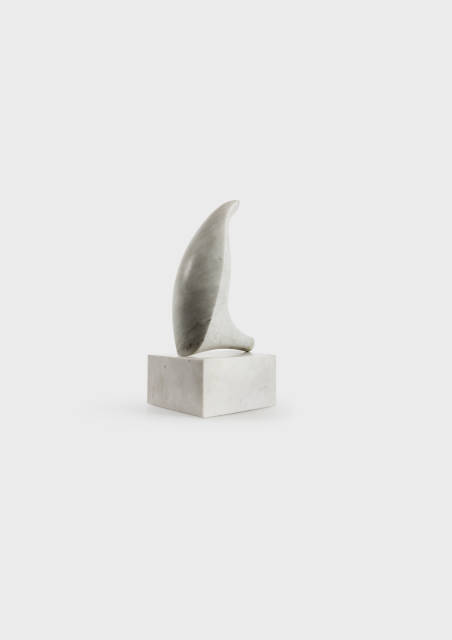- EN
Log in
- Live Auctions
- Past auctions
- More
- Gallery
- Art Dealing
- Publishing
- Kornfeld today
- The Story of Kornfeld
- Information






Strassburg 1886 - 1966 Basel
Sale time 13-09-2024,
about 15:05 h (CET)
(+/- 30 min)
1941
Marble
44x22.2x22 cm
Studio of the artist, acquired before 1955 from
Annie and Oskar Müller-Widmann Collection, Basel, by inheritance to
Collection Aja Petzold-Müller, Basel, by inheritance to
Private collection Switzerland
Auction Christie's, Paris, 22 October 2021, lot 330, acquired there from
International private collection
Carola Giedion-Welcker, Jean Arp, Stuttgart 1957, no. 63, p. 110 (different version), ill. p. 68
Ionel Jianou, Jean Arp , Paris 1973, no. 63, p. 69
Arie Hartog/Kai Fischer, Hans Arp, Skulpturen - eine Bestandsaufnahme, Ostfildern 2012, no. 63
Intended for exhibition at the Fundació Catalunya La Pedrera, Barcelona, Art in Stone, October 2024
One side on top slightly rubbed due to the possibility of turning around the axle. In very good condition
Hans Arp's works were considered "degenerate" in the Third Reich. After the occupation of France, he and his wife Sophie Taeuber-Arp therefore moved to Grasse on the Côte d'Azur. There he had no studio and was forced to work as a painter and sculptor with light, portable and cheap materials. Thanks to donations from patrons, the Arps were able to keep their heads above water before fleeing to Switzerland in late 1942 to escape the advancing German Wehrmacht. It was precisely during these turbulent times that the design for this work was created. However, the work was probably not carved in marble until later in Ticino.
Arp's distinctive vocabulary of biomorphic forms made him an important pioneer of abstract sculpture. Oscillating and flirting with titles, his works occupy a special place in modern sculpture. In the present sculpture, the artist explores growth, metamorphoses and botanical fertility, as he often did during this period. With his characteristic figures, Arp succeeded in a unique way in transforming organic forms into a factually abstract, lyrical formal language. In the present case, it is an impressive mixture of dynamic and static, excitingly realised with an emphasis on the vertical. A seemingly delicate amorphous leaf rests on a plinth. Carved in white marble, the object surprises with its complex curves and, when viewed from different angles, completely different, ever-changing shapes.
A unique variant of two versions. The other version is in the collection of the Kunstmuseum in Winterthur.
1941
Marmor
44x22,2x22 cm
Atelier des Künstlers, vor 1955 erworben von
Slg. Annie und Oskar Müller-Widmann, Basel, durch Erbschaft an
Slg. Aja Petzold-Müller, Basel, durch Erbschaft an
Privatsammlung Schweiz
Auktion Christie's, Paris, 22. Oktober 2021, Los 330, dort erworben von
Internationaler Privatsammlung
Carola Giedion-Welcker, Jean Arp, Stuttgart 1957,
Ionel Jianou, Jean Arp , Paris 1973,
Arie Hartog/Kai Fischer, Hans Arp, Skulpturen – eine Bestandsaufnahme, Ostfildern 2012,
Vorgesehen für die Ausstellung in der Fundació Catalunya La Pedrera, Barcelona, Art in Stone, Oktober 2024
Eine aufliegende Seite durch die Drehmöglichkeit um die Achse leicht berieben. In sehr schöner Erhaltung
Hans Arps Werke galten im Dritten Reich als "entartet". Nach der Besetzung Frankreichs zog er daher mit seiner Frau Sophie Taeuber-Arp nach Grasse an die Côte d'Azur. Dort hatte er kein Atelier und musste als Maler und Bildhauer notgedrungen mit leichten, transportablen und billigen Materialien arbeiten. Dank Zuwendungen von Gönnern konnten sich die Arps über Wasser halten, bevor sie Ende 1942 vor der anrückenden deutschen Wehrmacht in die Schweiz flohen. In genau diesen bewegten Zeiten ist der Entwurf der vorliegenden Arbeit entstanden. Vermutlich wurde das Werk jedoch erst später im Tessin in Marmor gehauen.
Arps unverwechselbares Vokabular biomorpher Formen machte ihn zu einem wichtigen Wegbereiter der abstrakten Plastik. Oszillierend und mit den Titeln kokettierend nehmen seine Werke eine Sonderstellung in der modernen Bildhauerei ein. In der vorliegenden Skulptur thematisiert der Künstler, wie oft in dieser Zeit, das Wachstum, Metamorphosen und die botanische Fruchtbarkeit. Auf einzigartige Weise gelang Arp mit seinen charakteristischen Figuren die Umwandlung organischer Formen in eine faktisch abstrakte, lyrische Formensprache. Im vorliegenden Fall ist es eine eindrückliche Mischung aus Dynamik und Statik, spannend umgesetzt mit der Betonung der Vertikalen. Auf einem Sockel ruht ein scheinbar filigranes, amorphes Blatt. Das aus weissem Marmor gehauene Objekt überrascht mit komplexen Rundungen und, betrachtet man es aus verschiedenen Blickwinkeln, völlig unterschiedlichen, immer wieder neuen Formen.
Einzigartige Variante von zwei Versionen. Die andere Fassung befindet sich in der Sammlung des Kunstmuseums in Winterthur.
| Switzerland | CHF | Individual offer |
| Europe | CHF | Individual offer |
| Overseas | CHF | Individual offer |







